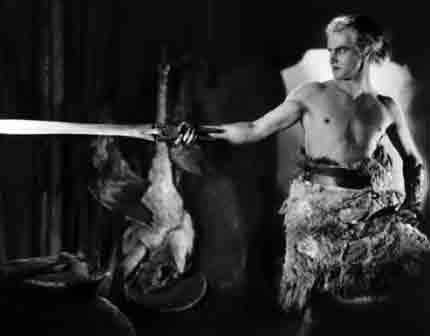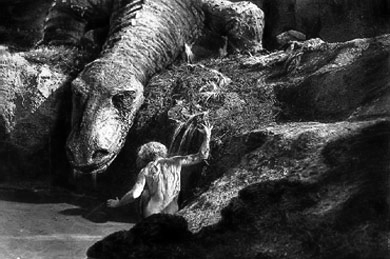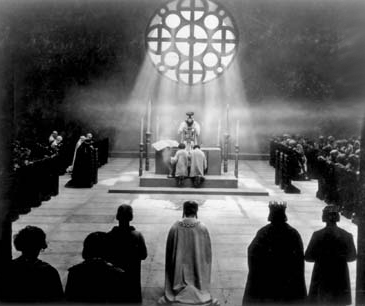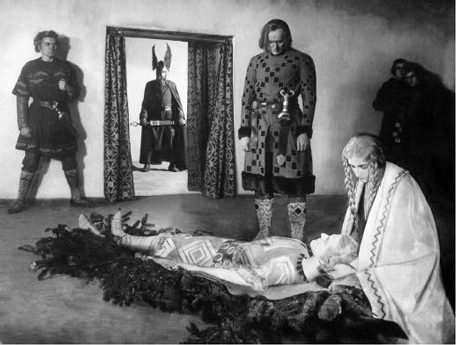
 |
|
|
|
"Hate, Murder and Revenge!" That line of song lyrics comes from Fritz Lang's stylized western Rancho Notorious, but its nihilism applies to much of Lang's work. Near the beginning of his directing career Lang made two silent films that expanded into two-part epics. The pulp crime fantasy Dr. Mabuse Der Spieler distills all the ills of the 20th century into a single criminal madman. A third myth of the machine-age future, Metropolis might have fared better if it were released as two films. But Lang's most popular epic reaches back 800 years to the core of the German cultural heritage: The Song of the Nibelungs (The Nibelungenlied). 
Referencing the original myth behind Wagner's opera, Lang and Thea von Harbou's Die Nibelungen is yet another world classic that once existed only in ragged, grossly incomplete copies. Kino's new Blu-ray is perhaps the first satisfying release of this two-part epic, and the first time that its full storyline can be understood without resort to reference books. Titled Siegfried and Kriemheld's Revenge, the film's two parts cover a lot of narrative territory. Part One introduces Siegfried (Paul Richter) as he forges a sword. Siegfried slays the dragon Fafnir and makes himself invincible by bathing in the dragon's blood. Overcoming the treacherous Alberich (Georg John, who also plays two other roles) he acquires the treasure of a race of demonic dwarves called the Nibelungs. In addition to the Balmung sword, the booty includes the Tarnhelm, a magic helmet -- here more like a net - with special powers. Having heard of the beautiful Burgundian princess Kriemhild (Margarete Schön), Siegfried conquers twelve kingdoms to be worthy of her. At the capitol at Worms, Siegfried asks for Kriemhild's hand. Her physically weak brother Gunther demands a price: Siegfried must accompany him to Iceland, to win for Gunther the hand of Queen Brunhild. The warrior queen has her own conditions -- the man she marries must defeat her in three contests. Siegfried uses the Tarnhelm to fool Brunhild into thinking Gunther an athlete. She accompanies them back to Worms, but refuses to yield to Gunther on his wedding night until Siegfried again uses magic to subdue her. His deception triggers a tragic series of events that end in "Hate, Murder and Revenge." 
Populated by weird dwarves, monsters and legendary heroes, Siegfried is packed with masterful visuals. Lang's architectural training is given a workout in the enormous sets created for the German forest, with tree trunks as big as giant sequoias. The pomp and ceremony at Worms is reflected in grand, harmonious symmetrical compositions. One mesmerizing setup trucks along a long line of soldiers in metal helmets, with identical jagged patterns on their tunics. Another group of soldiers stands in the water in full armor, using their shields to form a walkway for Brunhild to walk from a boat to the shore. Visual symbols stand out prominently, as when a flowering tree changes into a death's head to foretell a murder to come. The dragon is a full-scale mannequin operated by several men... it has a real flamethrower in its head. The noble characters are deeply flawed. Siegfried is a grand hero, but once he has slain the dragon, his further success is all gained with the help of magical acquisitions: the sword, a magic helmet. With those powers, anybody could conquer twelve kingdoms. In the latter part of the story the royals' deceits and jealousies set into motion a domino-like series of awful events. Shocked to learn that Gunther didn't win Brunhild fair and square, Kriemhild tells Brunhild. Humiliated, Brunhild tells Gunther a lie about Siegfried on their wedding night. The proud Gunther dispatches his sinister hatchet man Hagen Tronje (Hans Adalbert von Schlettow) on a murder mission. Unfortunately, Siegfried's invulnerability has a flaw, just like the Greek hero Achilles. Strangely, Kriemhild is usually assigned most of the blame despite the fact that she loses the most. Nobody in the poisonous inner circle at Worms acts in a truly ethical manner. Kriemhild strikes back in the more literal, political Part Two, Kriemhild's Revenge. She responds to the marriage proposal of the foreign conqueror Attila the Hun (or Etzel, Rudolf Klein-Rogge), journeys to his Eastern Fortress and bears him a son. Attila takes time from laying siege to Rome to come home to see the boy. He gladly allows Kriemhild to invite Gunther and her brothers for a visit, but refuses her demand that he kill Hagen Tronje, because he is a guest. Gunther refuses to kill Hagen as well. At a banquet Kriemhild bribes some Huns to attack the Burgundians, 1 and a battle begins. A general bloodbath wipes out almost everyone. 
A bold title card announces that the films are "dedicated to the German People". That seems almost scary, considering that the German Burgundians seem intent on self-destruction. The unalterable will of Kriemhild dominates every step of Revenge. After the cruel tragedy of Part One, nationalities, bloodlines, familial love, matrimonial love mean nothing to Siegfried's widow. She doesn't mind if everyone and everything is destroyed. Kriemhild provokes a slaughter and a fiery siege of Attila's grand hall, and the once magical world of limitless possibilities goes up in smoke and flames. Unlike Part One, there is much more action within the frame, especially when the story moves eastward into the land of the Huns. The rigid compositions of soldiers at Worms are replaced by Attila's ragged and informal groupings of peasant warriors, cavalrymen that aren't happy unless they're in the saddle. Producer Erich Pommer allows Lang to show hundreds of mounted Huns charging across vast hills and valleys. Attila is an old man with hideous scars, but his boundless joy and open emotions make him seem much more human than the scheming Burgundians. Gunther, Kriemhild and Hagen Tronje's seem dedicated to morbid death pacts in the name of honor. At one point Attila exclaims that he doesn't understand what the problem is with these radical Burgundians. Fritz Lang truly bloomed as a filmmaker in these epics. His Dr. Mabuse is a Feuillade-like serial gone psychotic, using expressionism to depict a new kind of 20th century paranoia. In Die Nibelungen Lang works with cinematic contrasts. The Burgundians are all stiff poses and rigid compositions, while the fur-clad Huns creep and loiter like animals on the prowl. Critic Lotte Eisner reminds us that Lang's architectural designs extend to the use of groups of people as geometric shapes. They are stylized but not strictly expressionist, as they are never actually physically distorted for psychological effect. The enormous cathedral is credible as a real setting. Theatrical grotesquery is very much present as well. Fanciful characters like Alberich are portrayed as they might be on a stage, with plenty of exaggeration. The dreaded Hagen Tronje, the film's chief betrayer and agent of wrongdoing, is simply a grim black knight, with a long beard and an extinguished right eye. Siegfried and Kriemhild are more modern in conception, and not the heavy singers we're accustomed to seeing on stage. The only change to the 'vengeful' Kriemhild is her more severe eye makeup. 
The enormous sets were built on open land, not in studio interiors. We're told that the giant trees in Siegfried's forest were wooden frames covered with sculpted concrete. The static camera setups lead us to think that many scenes are matte paintings or foreground miniatures, but when Siegfried rides through the forest, it's clear that everything we're seeing is real. Special in-camera effects so see service to depict the northern lights and 'bogs of fire' in Brunhild's Iceland, as well as Siegfried's tricks of invisibility. The virtuosity of this in-camera effects work gave German filmmaking an early reputation for technical excellence - Hollywood would import Ufa's cameramen as well as its directors. Kino Classics' Blu-ray Special Edition of Die Nibelungen is a dazzling new 2-disc restoration of this enduring film classic, reconstructed by the Friedrich-Wilhelm-Murnau-Stiftung. Together the two parts are over 4.5 hours long. The transfers are quite good, even considering the cut & paste job of collating all available surviving materials into the longest version yet. Some shots and short scenes are from less-than optimum sources, but even they are stable and free of damage. The static compositions of characters posed amid giant arches and looming trees become as impressive as the still photographs reproduced in film books. Transferred at a proper film speed, the action is more readable. The dragon's fire can be seen to touch Siegfried's armor, and a bit of abstract animation in Kriemhild's vision is now effectively dreamlike. The artwork transformation of the flowering tree is a powerful instance of silent movie symbolism. Even though many scenes and actions are on the slow side, the pace builds throughout. Lang's show has the gravity of a real saga. One can finally appreciate just how big of a film experience this was in 1924, when the two parts were played on alternate nights. Although often screened with a Wagnerian musical backing, this presentation is accompanied by a new orchestral recording of Gottfried Huppertz' original music score, which is just as attractive as the composer's work on Metropolis. 
A 70-minute documentary by the German restoration team examines the film in full detail: the filming, its political relationship to the Third Reich (which excerpted it many times in its propaganda movies), the endless number of alternate versions, and the exacting choices made in creating this new integral version. Just one of many interesting discussions in the docu covers the first-time-ever inclusion of a crucial sword stroke at the very end of the film. Before, it looked as if a certain character just drops dead for some reason. The restoration experts speak on camera, describing the information they had to work from and the logic behind their decision to include this rediscovered detail. Also viewable are some newsreel shots of Fritz Lang directing. Kino's grand restoration of Die Nibelungen probably won't attract the attention given Metropolis, but it is an equally eye-opening Blu-ray event.
On a scale of Excellent, Good, Fair, and Poor,
Die Nibelungen Blu-ray rates:
Footnote:
1. Can't resist: these are not "The Knights Who Say Nibelungen."
Reviews on the Savant main site have additional credits information and are often updated and annotated with reader input and graphics. Also, don't forget the 2011 Savant Wish List. T'was Ever Thus.
Review Staff | About DVD Talk | Newsletter Subscribe | Join DVD Talk Forum |
| ||||||||||||||||||